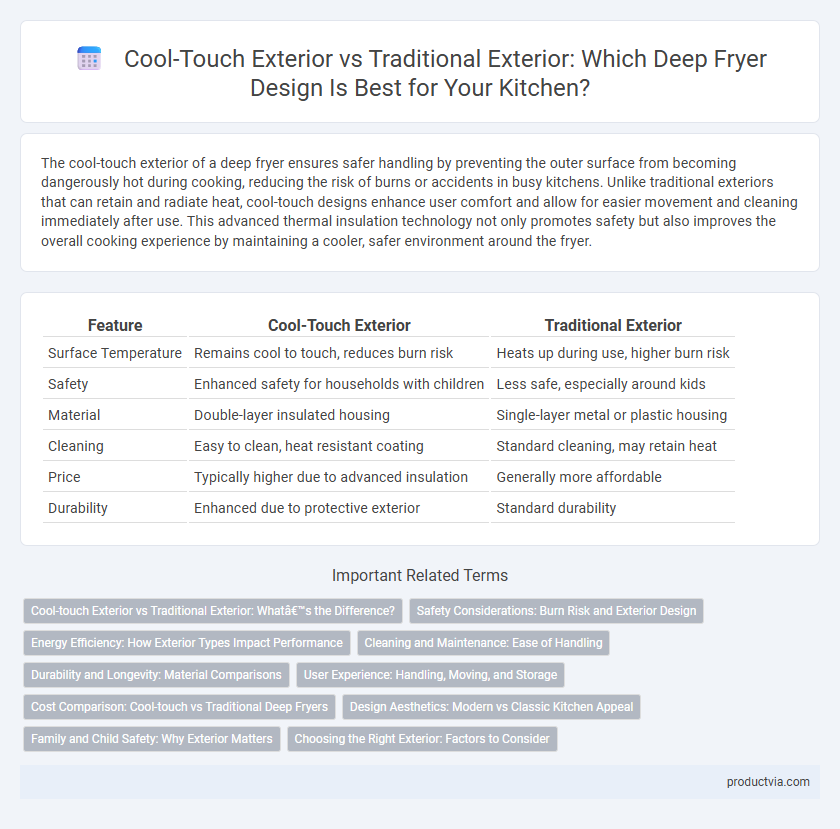The cool-touch exterior of a deep fryer ensures safer handling by preventing the outer surface from becoming dangerously hot during cooking, reducing the risk of burns or accidents in busy kitchens. Unlike traditional exteriors that can retain and radiate heat, cool-touch designs enhance user comfort and allow for easier movement and cleaning immediately after use. This advanced thermal insulation technology not only promotes safety but also improves the overall cooking experience by maintaining a cooler, safer environment around the fryer.
Table of Comparison
| Feature | Cool-Touch Exterior | Traditional Exterior |
|---|---|---|
| Surface Temperature | Remains cool to touch, reduces burn risk | Heats up during use, higher burn risk |
| Safety | Enhanced safety for households with children | Less safe, especially around kids |
| Material | Double-layer insulated housing | Single-layer metal or plastic housing |
| Cleaning | Easy to clean, heat resistant coating | Standard cleaning, may retain heat |
| Price | Typically higher due to advanced insulation | Generally more affordable |
| Durability | Enhanced due to protective exterior | Standard durability |
Cool-touch Exterior vs Traditional Exterior: What’s the Difference?
Cool-touch exterior deep fryers feature insulated walls that prevent heat transfer, ensuring the outer surface remains safe to touch during cooking. Traditional exterior models often have metal surfaces that become hot, posing burn risks and requiring caution when handling. The cool-touch design enhances user safety and comfort, making it ideal for home kitchens with children or frequent use.
Safety Considerations: Burn Risk and Exterior Design
Cool-touch exterior deep fryers significantly reduce burn risk by maintaining a lower surface temperature during operation, enhancing user safety in home and commercial kitchens. Traditional exterior models often reach high temperatures on the outer shell, increasing the likelihood of accidental burns, especially in busy cooking environments. The advanced insulation and heat-resistant materials in cool-touch designs offer a crucial safety benefit by preventing direct contact with hot surfaces while frying.
Energy Efficiency: How Exterior Types Impact Performance
Cool-touch exterior deep fryers enhance energy efficiency by minimizing heat loss, maintaining consistent internal temperatures, and reducing the workload on heating elements. Traditional exterior deep fryers often allow more heat dissipation, leading to longer cooking times and increased energy consumption. Investing in cool-touch technology optimizes energy use, lowers electricity bills, and promotes safer handling during operation.
Cleaning and Maintenance: Ease of Handling
Cool-touch exterior deep fryers offer significant advantages in cleaning and maintenance due to their heat-resistant outer shells, which prevent burns and allow for safer, more comfortable handling during routine tasks. Traditional exterior models often retain higher surface temperatures, increasing the risk of injury and making careful handling essential when cleaning grease and food residues. The enhanced safety of cool-touch designs facilitates quicker, more efficient cleaning without the need to wait for prolonged cooling periods, improving overall ease of maintenance.
Durability and Longevity: Material Comparisons
Cool-touch exterior deep fryers typically feature advanced heat-resistant materials like silicone or specialized coatings that enhance durability by preventing surface degradation and warping during prolonged use. Traditional exterior deep fryers often use standard metal or plastic housing, which may be more prone to discoloration, cracks, and heat damage over time. The use of high-quality, heat-insulating materials in cool-touch models contributes to longer product lifespan and sustained aesthetic appeal compared to conventional designs.
User Experience: Handling, Moving, and Storage
Cool-touch exterior deep fryers enhance user experience by remaining safe to touch during and after cooking, reducing the risk of burns and allowing easier handling. Their insulated design often results in lighter, more maneuverable units compared to traditional deep fryers with metal exteriors that heat up significantly. These features improve convenience in moving and storing the deep fryer, especially in compact kitchens or busy environments.
Cost Comparison: Cool-touch vs Traditional Deep Fryers
Cool-touch deep fryers typically come at a higher initial cost compared to traditional models due to advanced safety features and insulated materials. Despite the increased upfront price, cool-touch exteriors can reduce maintenance expenses and minimize the risk of burns, potentially lowering indirect costs over time. Traditional deep fryers, while more affordable initially, may incur higher medical or liability costs due to their hotter surfaces.
Design Aesthetics: Modern vs Classic Kitchen Appeal
Cool-touch exterior deep fryers feature sleek, modern designs with smooth finishes and minimalistic lines that complement contemporary kitchen aesthetics. Traditional exterior models often showcase a classic, utilitarian look with exposed metal components and bulkier shapes suited for vintage or rustic kitchen styles. The choice between these designs influences the overall kitchen appeal by aligning the fryer with either modern elegance or timeless simplicity.
Family and Child Safety: Why Exterior Matters
A cool-touch exterior on a deep fryer significantly enhances family and child safety by reducing the risk of burns during cooking. Unlike traditional exteriors that can reach dangerously high temperatures, cool-touch surfaces provide a safer environment in households with children. This safety feature helps prevent accidental contact injuries, making it a crucial consideration for family-focused kitchen appliances.
Choosing the Right Exterior: Factors to Consider
Cool-touch exterior deep fryers enhance safety by preventing burns during operation, making them ideal for households with children or frequent use. Traditional exterior models often provide better heat retention, contributing to consistent frying temperatures but pose higher burn risks. When choosing the right exterior, consider safety requirements, frequency of use, and the importance of temperature stability for optimal frying results.
Cool-touch exterior vs Traditional exterior for deep fryer Infographic

 productvia.com
productvia.com